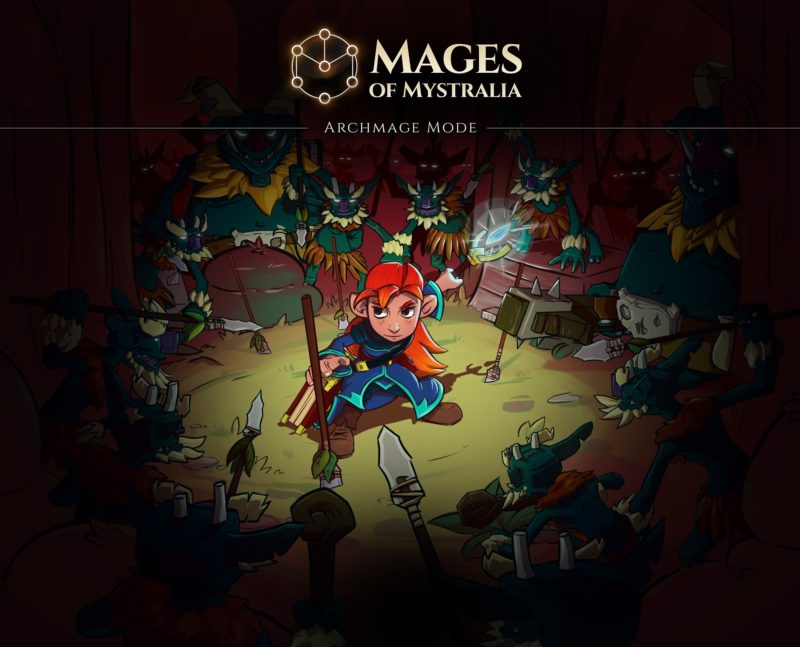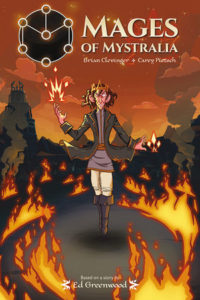
Mages of Mystralia Trade Paperback
Concept: Ed Greenwood
Writer: Brian Clevinger
Artist: Carey Pietsch
Cover Artist: Clement Pernel
Review by Malcolm Derikx
 I’ve always been a little bit wary of video game tie-in comics, in much the same way a video game fan may be hesitant of the video game adaptation of their favorite movie. It’s an unfortunate truth that in the hierarchy of media forms whenever you’re making a tie-in product, it’s very likely to turn into nothing more than an expensive advertisement for your main product. Unfortunately, Mages of Mystralia has this problem.
I’ve always been a little bit wary of video game tie-in comics, in much the same way a video game fan may be hesitant of the video game adaptation of their favorite movie. It’s an unfortunate truth that in the hierarchy of media forms whenever you’re making a tie-in product, it’s very likely to turn into nothing more than an expensive advertisement for your main product. Unfortunately, Mages of Mystralia has this problem.
Mages of Mystralia, by Borealys Games from Montreal, was a very successful Kickstarter that was released on Steam, Xbox One, and PS4 this past summer. Described as a Legend of Zelda/Harry Potter hybrid, Mystralia is an action-adventure centered around the idea that you can build your own spells. With its own cutesy art style, like Wind Waker, and written by Ed Greenwood (you know, the guy who made the Forgotten Realms for Dungeons and Dragons?), it was a pretty instant hit upon release. This is all the more reason why Mages of Mystralia, the comic, makes me feel really sad.
I’m not quite sure what happened in the making of Mages of Mystralia, but all of those cool world-building elements, the idea of creating unique spells, and the monsters that inhabit the world, they’re almost entirely absent. The story takes place 100 years before the events of the video-game, detailing the Mage-King Aetius’ descent into madness in pursuit of more powerful magic. Aetius’ descent is actually more like a slip-n-slide he takes a running leap down. He starts off as a pretty big jerk, and he quickly becomes a paranoid genocidal jerk, banning magic throughout the Kingdom and attacking his subjects with impunity. Unfortunately, all the other characters exist only in relation to him. For most of the comic, either Aetius’ Battle-Captains, or Mystralia’s Seers, talk about Aetius’ latest act of villainy, and how they need to act against him.
While I can get behind high fantasy tropes of heroic warriors, wise mages and power-mad Kings, it’s very bare-bones and the characters do little, if anything, to differentiate themselves from their stereotypes. The four Battle-Captains are pretty much interchangeable, and Sabinus the Heretic, a mage who shows up in the second-half of the story, surely has a larger role to play in the game given how the characters react to his name and arrival. But, within the comic none of this is explained. It’s clear that the comic is meant for fans of the game who want to learn more about the lore. Unfortunately, it shows very little of what makes Mages of Mystralia such a cool setting.
The comic starts off promisingly enough, with the Battle-Captains being dispatched to deal with Plague Trolls harassing the local populace. The concept of Plague Trolls is a very cool one, and I love the designs (more on that later), but we never really get a chance to SEE the battle with the trolls. We get a panel or two of the skirmish at the front-lines, but there isn’t ever an example of the Battle-Captains directly battling the menace. This is a reoccurring problem in the comic: characters spend a lot of time talking about things that have happened or will happen.
Perhaps this wouldn’t rub me so wrong, if Mages of Mystralia was a bad game. But, it’s not a bad game; it’s a really cool game, with some really cool ideas! The back of the book contains some character art, showcasing Ice Lizards, Goblins, Magma-Beetles, and it even references Franco-Belgian comics (Ligne Claire) as a direct source of artistic inspiration for the video game. It’s very imaginative and I loved it all. So… why did none of this appear within the comic itself? The fantasy-elements of the world seem to be downplayed in the comic entirely in favor of the human characters talking politics. Magic, the central concept of the video-game, is treated very abstractly. We’re never told how it works exactly, or why certain types, such as Celestial Magic, are more dangerous than others. There isn’t any mention of the unique spell creation system, which is the hook that makes Mystralia different from other run-of-the-mill fantasy worlds.
Art-wise, there is no doubt that Carey Pietsch is talented, with a strong sense of color and mood. His characters are visually distinct, and his pages are clear to understand. While undoubtedly drawn in a more simplified, cartoon-style, his panels are nevertheless peppered with detail, and you really feel like this is a living breathing world. Of specific note, the fight between Aetius and the Seers is where Pietsch really stands out. The clashing blues and reds, with gathering murky storm-clouds, makes for an impressive scene, and there’s a few other pages where I sat back and had to give a nod of appreciation for his work.
Truth be told, I’m not sure how much of the problems with Mages of Mystralia can be placed upon Brian Clevinger. He’s writing a script based off Ed Greenwood’s story, and with the comic being tied explicitly to a video-game property, there’s a question of how much narrative freedom was really given in the first place to explore the world. Perhaps these more interesting aspects of the world were being saved for the game to explore more in-depth? It’s a distinct possibility, but at the end of the day it unfortunately turns the comic into just a very long video-game trailer.
Verdict:
Skip it. The end of Mages of Mystralia is followed by a page plugging the video game, which will “continue the story.” Overall, this ends up cheapening everything you’ve experienced, and it left me with a bad taste in my mouth. At least at the end it’s honest that it’s a marketing ploy.
Mages of Mystralia is in stores on January 17, 2018.



